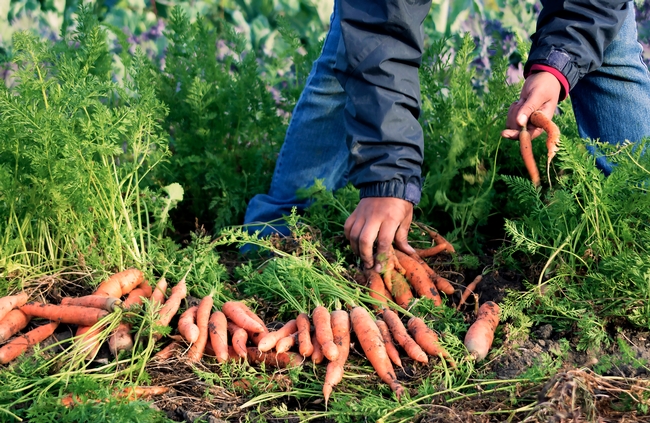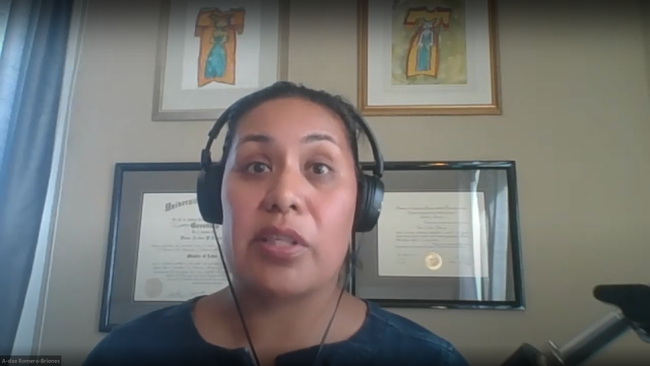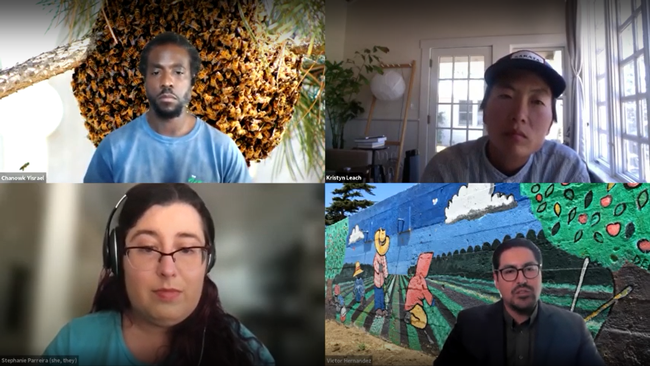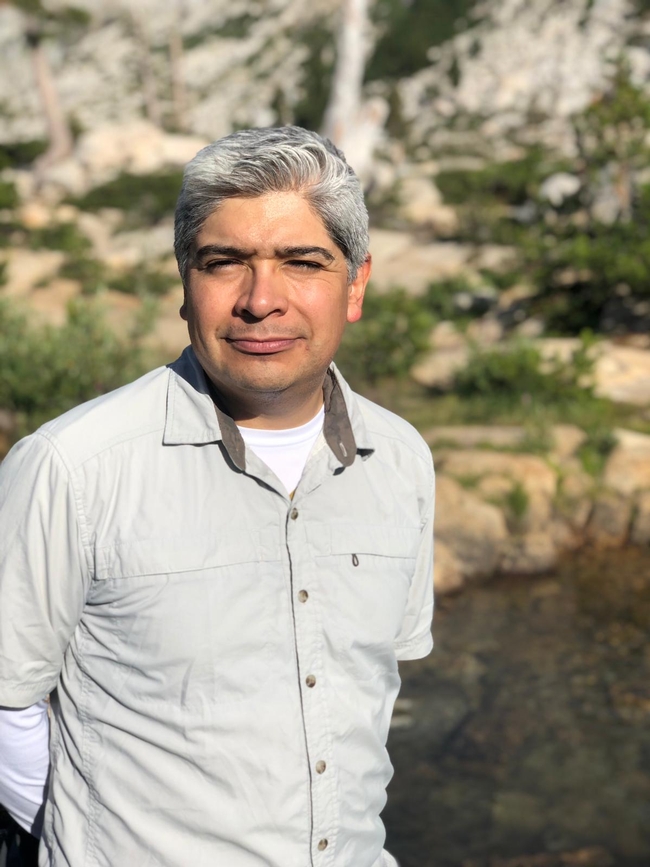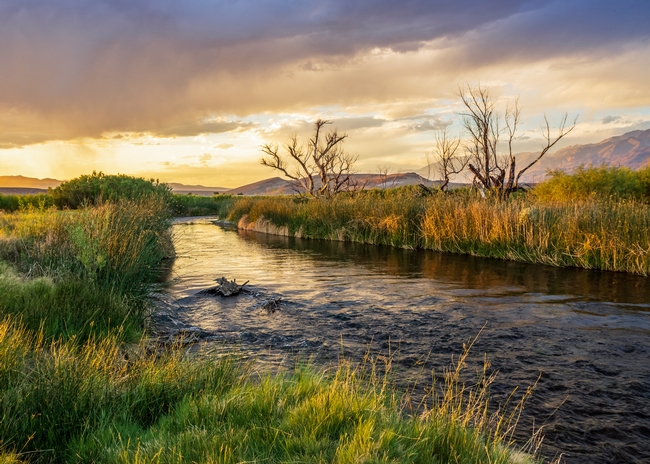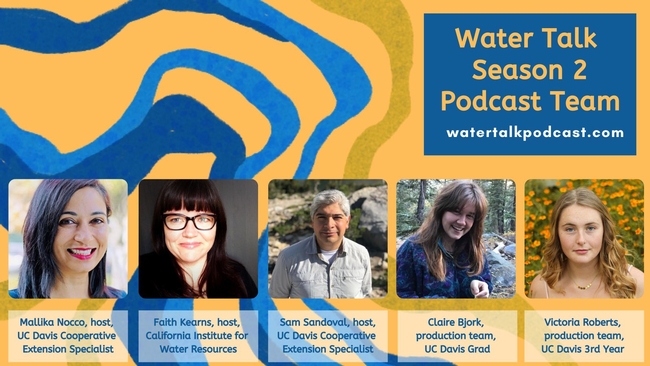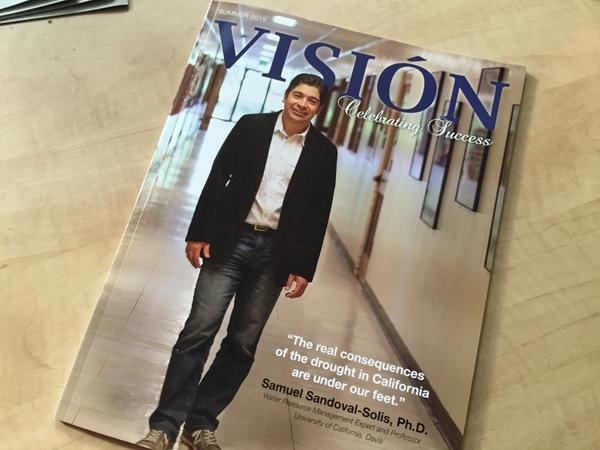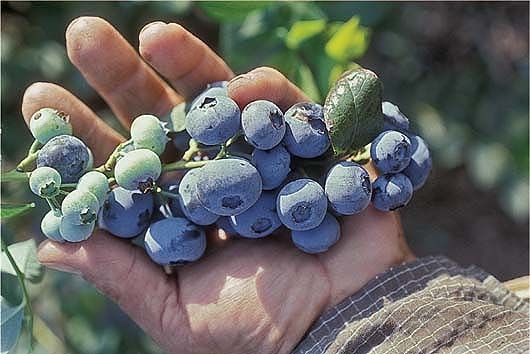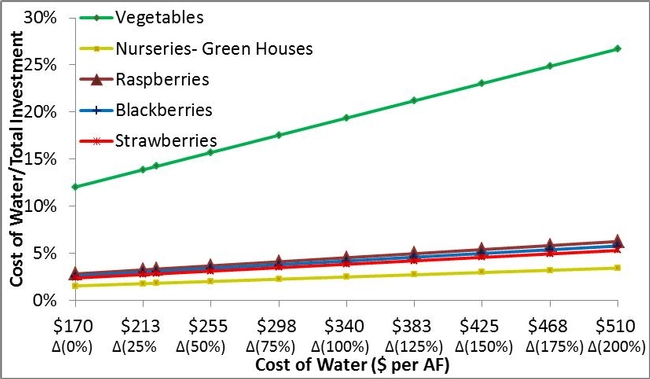Posts Tagged: Samuel Sandoval
Farmers of color share their contributions, concerns in UC SAREP webinar series
When agricultural advisors came to the Cochiti Pueblo in New Mexico during the 1940s, they lined the irrigation ditches with concrete, in the name of boosting efficiency and productivity. But in single-mindedly focusing on water delivery, they neglected to consider how the previously inefficient seepage sustained nearby fruit trees.
Their actions, as well-intentioned as they might have been, disrupted the local ecosystem and killed the trees that had fed many generations, according to A-dae Romero-Briones, who identifies as Cochiti and as a member of the Kiowa Tribe.
“In my language, we call the extension agents ‘the people who kill the fruit trees,'” said Romero-Briones, director of the Food and Agriculture Program for the First Nations Development Institute, a nonprofit that serves Tribal communities across the mainland, Alaska and Hawaii.
The historically tense relationship between Indigenous peoples and government-affiliated programs is one of the many complex dynamics discussed in a six-part webinar series, “Racial Equity in Extension,” facilitated by UC Sustainable Agriculture Research and Education Program.
Making communities of color in the agricultural sector more visible is a priority for Victor Hernandez, a sociologist and outreach coordinator for the USDA's Natural Resources Conservation Service. Hernandez, who has organized “Growing Together” conferences for Latino and Black farmers, is trying to get more farmers of color to participate in the upcoming 2022 Agricultural Census.
“If we cannot quantify the demographic, we cannot justify the need,” emphasized Hernandez, explaining that his office uses the data to direct resources that advance equity in service, program delivery and distribution of funds.
A legacy of mistrust
At the same time, however, Hernandez also acknowledged the challenges in registering growers of color for the census, conducted by the USDA's National Agricultural Statistics Service. (According to Brodt, USDA's most recent agricultural census, dating to 2017, counts approximately 25,000 producers of color among 128,535 total producers in California.)
“Many of us that are considered socially disadvantaged or historically underserved…a lot of times our peoples come from [nations with] oppressive governments,” Hernandez said. “And so when you come to the United States and you begin to build your life here, to go and engage with the federal government is not the first knee-jerk reaction.”
On top of government mistrust and fears of deportation or detention, other immigrant groups have seen mainstream agriculture – borne by the “Green Revolution” wave across the globe – replace deep-rooted cultural practices, said Kristyn Leach of Namu Farm in Winters.
“It just makes these small farmers distrust our own knowledge, the knowledge that's existed for centuries – before the kind of current iteration of agriculture that we're situated within right now,” said Leach, who works to preserve the agricultural heritage of her Korean ancestors, and facilitates a farmers' collaborative called Second Generation that adapts Asian crop varieties to climate change.
According to Romero-Briones, a collective memory of supplanted culture also lingers in Indigenous communities. In the Cochiti Pueblo, “primarily a subsistence agriculture community” with a long history of corn cultivation, their practices are distinct from those in the mainstream – including regenerative and sustainable agriculture.
Building relationships takes commitment
Given that legacy of cultural displacement and appropriation, how do extension professionals and other agricultural advisors slowly rebuild trust with communities of color? For Romero-Briones, it begins with a genuine respect for Indigenous practices, and she urges interested people to contact their local tribal historic preservation officer to begin strengthening those connections and understanding – beyond a couple of phone calls.
“As someone who works with Indigenous people all day, even I need to recognize sometimes I have to meet with people up to 12 times before we actually start talking about the work that I initially wanted to talk to them about,” Romero-Briones said.
In a similar vein, Chanowk Yisrael, chief seed starter of Yisrael Family Farms, encouraged listeners to reach out to members of the California Farmer Justice Collaborative – an organization striving for a fair food system while challenging racism and centering farmers of color.
“To use a farm analogy: we've got this ground, which is the farmers of color who have been neglected for a long period of time,” said Yisrael, who has grown his farm in a historically Black neighborhood of Sacramento into a catalyst for social change. “It's not just going to be as simple as just throwing some seeds and things are going to come up; you're going to have to do more – that means you got to get out and do much more than you would do for any other community.”
Investing time in a community is one thing – and backing it up with tangible resources is another. Technical expertise is only the “tip of the iceberg,” Leach said, as historically marginalized groups are also seeking land access and tenure, more affordable cost of living, and access to capital.
“All of those things are actually much bigger burdens to bear for most communities of color than not having the knowledge of how to grow the crops that we want to grow, and not knowing how to be adaptive and nimble in the face of climate change," Leach explained, highlighting California FarmLink as an essential resource. (The “Understanding Disparities in Farmland Ownership” webinar includes a relevant discussion on this subject.)
Bringing diverse voices to the table
Another key is ensuring that farmers and farm workers of color are represented in management and decision-making processes. Samuel Sandoval, a professor in the UC Davis Department of Land, Air and Water Resources and UC Cooperative Extension specialist in water management, develops outreach programs in English and Spanish for everyone from farm workers to the “boss of the boss of the boss.”
“It has to be changed,” he said, “because at the end, the person who is going to operate the irrigation system and turn on or off the valves, the person who is looking if there's a leak or not – that's the person who's not being informed, or has not been informed on purpose.”
That exclusion of certain groups can lead to a loss of invaluable knowledge. Leach said there is a real danger in ignoring the wisdom of communities that have contributed so much to the foundation of food systems in California and around the globe.
“These really kind of amazing, sophisticated and elegant agroecological systems that we don't often legitimize through the scientific language and perspectives aren't seen as being really technically proficient – but, in many ways, they're more dynamic and more resilient than the things that we're perpetuating right now,” she said.
As a concrete example, Sandoval said that while extension advisors and specialists conduct studies to remedy a plant disease, farm workers might be developing – separately and in parallel – their own solutions by asking for advice from their social networks via WhatsApp, a phone application.
A reimagining of collaboration, Sandoval said, would include (and compensate) people working in the field for sharing their perspectives – bringing together academics and farmers, integrated pest management experts and pesticide applicators, irrigation specialists and those who do the irrigation.
A need to look within
Concerns about inclusion and validating alternate sources of knowledge apply also to the recruitment process in extension. Leach said that she has seen listings for advisor jobs that would require, at a minimum, a master's degree – which would automatically disqualify her, despite her extensive knowledge of Asian heirloom vegetables.
“When you look at a job description and you see ‘Asian crop specialist,' only required qualification is a master's degree, and then somewhere down the long list of sort of secondary desired, recommended things is some knowledge of Asian crops or communities…you know that just says a lot in terms of what has weight,” Leach explained.
Before organizations can authentically connect with communities of color, they should prioritize diversity in their own ranks, said Romero-Briones. First Nations Development Institute had to ensure that they had adequate representation across the many Tribes that they serve.
“Before we start looking out, we have to start looking in,” she explained, “and that means we have to hire Indigenous people who know these communities.”
For extension professionals and other members of the agricultural community in California, the UC SAREP webinar series has helped spark that introspection and a meaningful reevaluation of institutional processes and assumptions.
“These discussions have been tremendously illuminating and eye-opening,” Brodt said. “But hearing and learning is just the start – it's incumbent on us, as an organization and as individuals, to take action to ensure that farmers of color and their foodways are truly respected and valued.”
The “Racial Equity in Extension” series is made possible by professional development funds from Western Sustainable Agricultural Research and Education.
Drought is back! And so is Water Talk
The Water Talk podcast returns Friday, April 2, for its second season. This year's podcast will include a focus on the water issue on many minds at the end of a relatively dry rainy season: drought. As Water Talk co-host Faith Kearns says in the Season 2 preview episode, “in California, drought is not ‘if', it's ‘when'.”
The second season will include a diverse group of guests from every corner of the state; border to border. “We thought a lot about the geography of the state, the identities of the people with whom we were speaking, and the experts we were talking with, and the topics,” says co-host Mallika Nocco.
The weekly podcast will feature discussions of agriculture, water policy, environmental and social justice, land and wildlife management, water for cities, Indigenous perspectives on water, climate change, and other issues related to California water.
Some aspects of the podcast were modified in the second season as well. For example, instead of recording the podcast during a simultaneous live event, each episode was recorded with only the co-hosts. In addition, two production assistants supported the development of each episode.
“The Water Talk team has new members!” the group tweeted. “We were thrilled to welcome ultra-talented Claire Bjork and Victoria Roberts as production support for Season 2, thanks in part to a UC ANR Renewable Resources Extension Act grant.”
You can subscribe, listen and download all the episodes in Spotify, Apple and Google podcasts, as well as on the podcast's webpage. In addition to listening to the podcast, you can follow @podcast_water on Twitter for water-related news.
To catch up on Season 1 of Water Talk, visit watertalkpodcast.com.
The Water Talk podcast is hosted by Mallika Nocco, UC Cooperative Extension specialist in the UC Davis Department of Land, Air, and Water Resources; Faith Kearns, California Institute for Water Resources academic coordinator; and Samuel Sandoval Solis, UC Cooperative Extension specialist in UC Davis Department of Land, Air, and Water Resources.
Samuel Sandoval Solis shares his passion for water resource management
The cover story in the most recent issue of Visión Magazine details the passion and expertise of UC Agriculture and Natural Resources' water resources scientist Samuel Sandoval Solis, a UC ANR Cooperative Extension specialist based at UC Davis.
Solis was born in Mexico City and began contributing to the family income at the age of 13 as a grocery store bagger. He earned a bachelor's degree in civil engineering at Instituto Politecnico Nacional.
When Solis was hired to help a community of 300 manage its water resources, he was nervous about his abilities, the article said.
"However, like many hardworking Latinos, Samuel put his fear and doubts to the side, and decided to pursue this great opportunity," wrote reporter Vanessa Parra.
Solis earned a master's degree in hydraulics at Instituto Politecnico Nacional, and a Ph.D. in environmental and water resources engineering at the University of Texas, Austin. His research centered on the Rio Grande, a river shared by Mexico and the U.S. (Mexicans call the river Rio Bravo.)
"I was under friendly fire from people of both nations," Solis said. "Because I was doing my research in the Rio Grande/Bravo while living in Texas, people from the U.S. thought I was a spy and people from Mexico thought that I was a traitor," he said.
The language and culture barriers that Solis once perceived as negative characteristics became valuable assets when he joined the University of California. He is able to communicate with Spanish-speaking farmers on a personal level.
Solis began his work in California just as it was caught in the grip of the current four-year drought. The dry period, he said, can be viewed as a "tipping point" to change the way the state uses and manages its water. His research focuses on water planning and management.
"We develop methods for finding strategies to better distribute water, ensuring adequate quality and the right timing," Solis said. "We consider the scientific, social, environmental, and economic aspects of basins. Our goal is to improve California's water management through cooperation, shared vision and science-based solutions."
UC ANR researchers aim to minimize water use in blueberries
UC Agriculture and Natural Resources (UC ANR) researchers don't want to know how much water it takes to grow blueberries, but how little, reported Bradley Zint in the Los Angeles Times.
The story featured Darren Haver, a UC ANR Cooperative Extension advisor in Orange County and director of the UC South Coast Research and Extension Center in Irvine. At the center, blueberries are being grown with varying amounts of water to compare yield and quality. Because of the drought, farmers need to know how to minimize water use while maintaining a viable business.
"Part of my job as an advisor is to take that information and put it in a format that a farmer could use or the general public could use," he said. "It's my job to distill it down."
The story also notes that drought-tolerant dragon fruit are under study at that at the South Coast REC.
"We need to find more crops like this," Haver said.
Other drought news:
Diversification: A Response to Drought
Richard Jones, Growing Produce, April 27
Growers must prepare to make changes, especially if their sole focus is high-value crops, said Samuel Sandoval, UC ANR specialist in water resources management at UC Davis. “We're seeing many growers put a lot of investment risk on a resource — water — that's very unreliable. We need to think ahead of the curve and find systems that are more flexible,” he says. Sandoval's suggestion: diversifying with both permanent and annual crops.
Your water footprint is bigger than you realize
Laura Bliss, The Atlantic CityLab, April 28, 2015
In the developed world, every bite of food, every mile we drive, every light switch we flip relies on water. The average American has a "water footprint" of 2,220 gallons per person, per day. "The numbers are pretty accurate," says Doug Parker, director of the UC Agriculture and Natural Resources California Institute for Water Resources. "But my question is, what do you do with it? If I'm interested in solving the drought in California, using less energy from power plants doesn't really matter because that water can be used downstream by a farmer."
Optimizing irrigation may ease groundwater overdraft in Pajaro Valley
In the Pajaro Valley, an agricultural region in Monterey County, residents are being proactive about water conservation policies and seeking ways to save water.
Groundwater makes up roughly 90 percent of the water delivered by Pajaro Valley’s Water Management Agency (PVWMA). There is a current overdraft of groundwater in the aquifers of this region, which calls for immediate action to protect their water source. Historically, the amount of groundwater in the aquifer was above sea level so the amount of salt water in the freshwater aquifer was kept at bay. Removing too much water from the ground at a faster rate than it is being replenished has caused seawater from the Pacific Ocean to enter the aquifer as the water level tries to even out. This seawater intrusion impairs water quality because saltwater is too saline for both agriculture and human consumption.
PVWMA is implementing seven different projects to control this seawater intrusion. One of these projects is their agricultural conservation program.
Agricultural conservation program
PVWMA asked Samuel Sandoval Solis, Ph.D., UC Cooperative Extension specialist in the Department of Land, Air and Water Resources at UC Davis, to help them with their agricultural conservation program. PVWMA wanted to know the volume water that could be potentially saved and the resulting economic impact of water savings on the valley.
The key to agricultural water savings is to water a crop to its evapotranspiration (ET) value. The ET value indicates optimum water amounts that should be applied in order for the water to be completely beneficial to the plants. To estimate the potential water savings, Sandoval and his UC Davis team – undergraduate student Vicki Lin and Ph.D. students Jenna Rodriguez and Belize Lane – had to determine how many growers were surpassing a crop’s ET value. The scientists interviewed growers to find out the volume of water each grower applied to the crops and the amount of money they invested in crop production. A statistical analysis was completed with applied water data of growers from PVWMA, information from the growers’ interviews, and expert-provided ET values to check for accuracy.
The scientists also analyzed land-use data sets from 2009 and 2011 for this project. The analysis focused on 2009 because it was a normal year in terms of groundwater extraction. They determined that Pajaro Valley can save between 4,600 and 5,100 acre feet per year through conservation. This agricultural water savings program is anticipated to contribute to 41 percent of the region’s total water savings just by using water more efficiently.
Vegetable growers would take hard hit
This increase in water savings results in a direct decrease in revenue for PVWMA ranging from $842,000 to $929,000. To compensate for this loss in revenue, a potential increase in water extraction fee rates was analyzed. An increase in water fees will affect farmers, especially vegetable crop growers in the coastal region of Pajaro Valley because they already put 60 percent of their total net profits into their investment cost. These coastal vegetable growers currently receive estimated revenue of $3,910 per growing season. If their water rates are increased by 50 percent, or $103/AF, their revenue will be decreased 6.7 percent ($265) per growing season. The economic impact graph at right shows how an increase in rates will affect farmers, substantially lowering their net profit on crops. Growers of strawberries, raspberries, blackberries and nurseries have a larger return on their investments, so an increase in water fees will not affect them as dramatically.
The full 37-page report on this project can be downloaded from a link at the top of http://watermanagement.ucdavis.edu/cooperative-extension/water-savings-agriculture.

